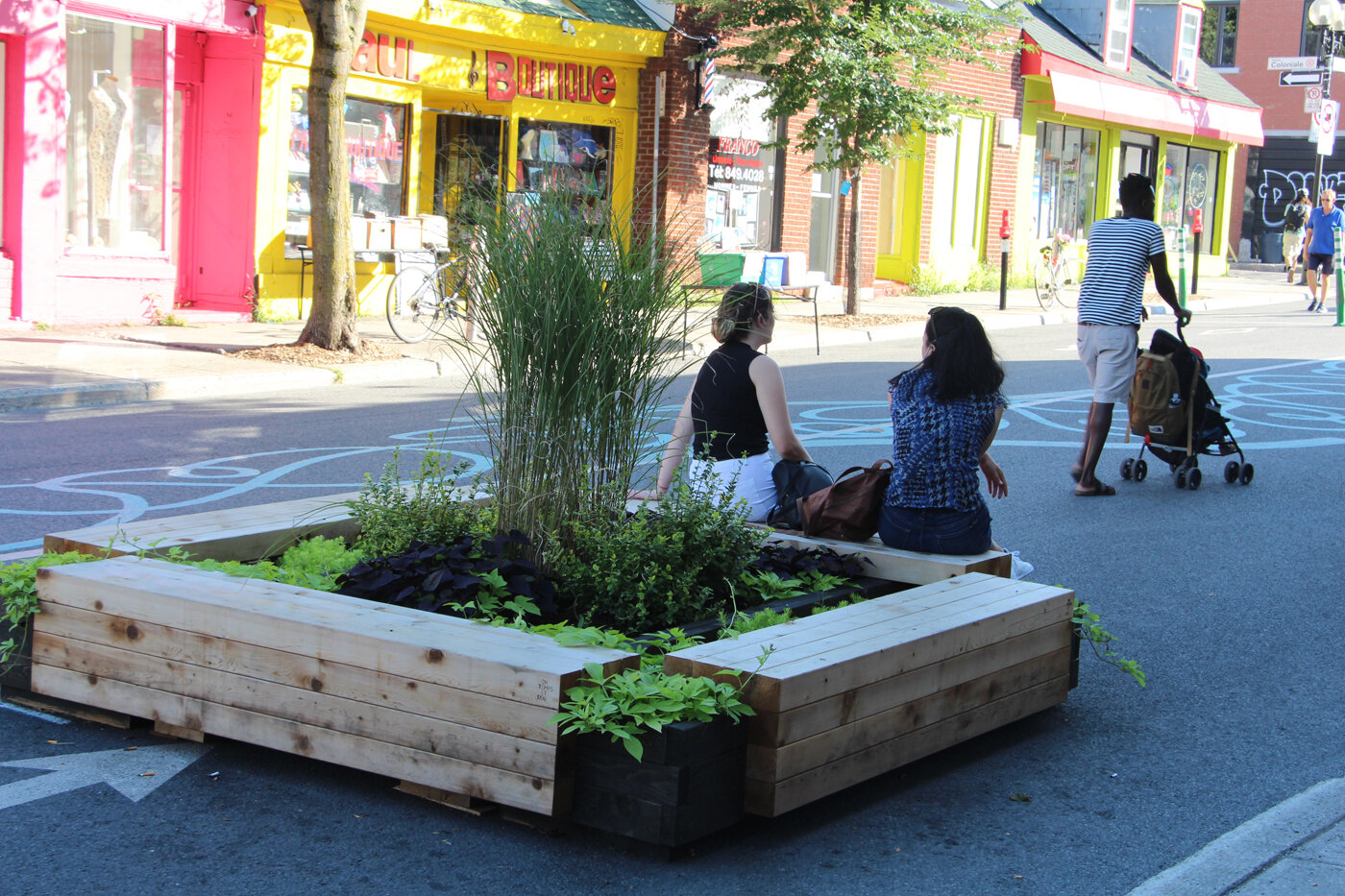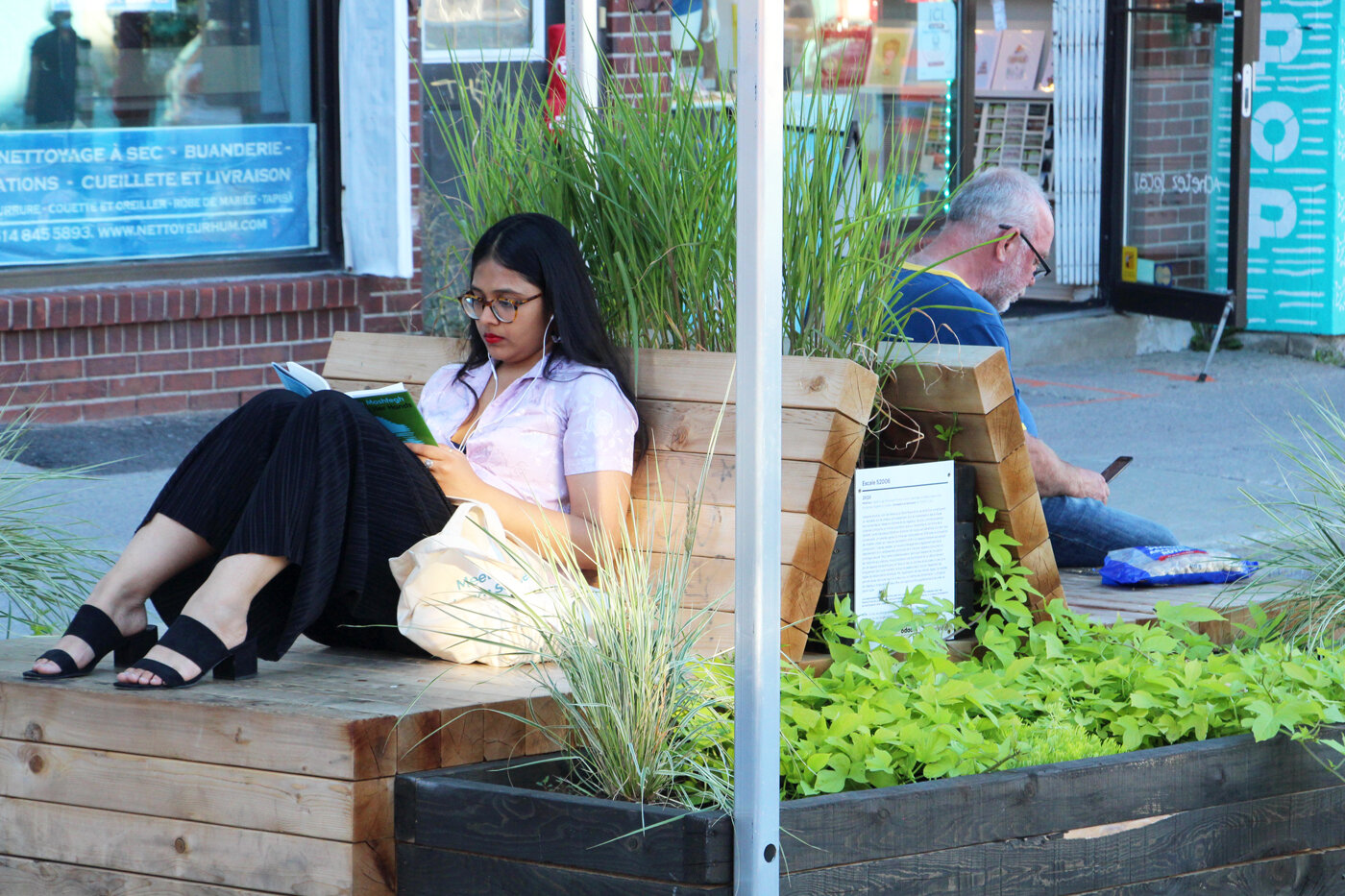Pedestrians and Pop-ups
Avenue Mont-Royal, Montréal (July 30 – August 15, 2020), PHOTOS CHRISTINE KERRIGAN
Back in April, I wrote about the health corridor that had been piloted and installed on Avenue Mont-Royal in Montréal’s Plateau Mont-Royal district. Now, many months later, the same street has undergone yet another transformation. Similar to several other designated commercial streets in Montréal, Avenue-Mont Royal has been converted into a pedestrian zone that stretches over roughly 2.7KM.
Restaurant terraces line the sidewalk and spill into the street, temporary benches and seating have been installed in multiple locations, the pavement has been painted with blue shapes, forms and illustrations, pop-up music and performances are taking place throughout the week, and the soundscape is filled with the chatter of human voices and music as opposed to the hum and honks of trucks and car engines.
In an effort to allow local businesses and restaurants to re-open during the COVID-19 pandemic, the Plateau Mont-Royal district chose to remove street parking, reroute vehicle traffic, open the street to pedestrians, and encourage residents and visitors to eat and buy locally while maintaining social distancing. Hand sanitizer dispensers have been installed at various locations along the street and masks are required for anyone entering inside an establishment. In fact, wearing a mask in enclosed or partially enclosed public or private spaces is a requirement in the entire province of Québec for anyone 12 and up.
How is Avenue Mont-Royal's street redesign affecting the various stakeholders impacted by the transformation? We need to gather both qualitative and quantitative data in order to answer this question and the results could vary greatly depending on the different stakeholder groups and the criteria chosen to evaluate the success of the project (i.e. economic indicators, attractiveness and ambiance, impact to the ecology and natural environment, mobility, health and safety, inclusion and equity, etc.). We need to consider the effects on the various users who frequent the area, such as: local residents by age group; non-residents by age group; people with reduced mobility; homeless; shop owners; shop employees; restaurant owners; restaurant employees; performers and artists; commercial delivery services; public transport operators; city employees; city officials; etc.
I surely can't speak for other users, but I can give you my perspective as an urban designer, action researcher, and local resident. Personally, I frick'n love it! Why? Aside from feeling happy to see our local businesses up and running once again, I also appreciate how the ambiance of the street has evolved over the past several weeks. For starters, the availability of more open public space is giving people with theatrical and musical talents a place to share their work and experiment. These pop-up performances are free and accessible to anyone passing by who chooses to stop, listen and even participate (donations are surely appreciated, but not required). A Roller Dance group called Roller Dance - Parc La Fontaine did a street performance with the collaboration of DJ Max Toupin, a DJ who spins tunes from his wheelchair alongside the dancers (video below). It's exactly this kind of performance that makes Montréal so unique and special.
Performance on Mont-Royal by Roller Dance- Parc Lafontaine
I serendipitously came across another performance called “One hour hug | in public.” In a flashmob style, with an artistic approach, couples and duos had been invited to hug for one hour in the middle of Avenue Mont-Royal. The event was organized by Patrice Marier and Julius Bitterling because they felt a “need to see more lovin’ around.” The creators explained that their intent was “not to disrespect social distancing, or to provoke, but rather encourage profound intimacy, vulnerability and receptivity with the few people we are able to be close with during this time.”
“One hour hug | in public” performance, PHOTO Christine Kerrigan
Some enterprising folks are also spontaneously using the space as a place to make and sell their products. People with reduced mobility have a lot more room to maneuver (just ask DJ Max) and a free shuttle service is being offered to the elderly and those with reduced mobility to compensate for the removal of the bus service that ran down the avenue.
The installation of several freestanding seating areas allows people to rest and enjoy the area without spending as much as a loonie (that's Canadian for $1 ). Several of the temporary seating areas also provide a canvas or roof to shade from the sun's powerful summer rays or protect people from inclement weather. Since many of the terraces and newly installed public seating areas contain plants and flowers, I suspect that our Plateau pollinators may also give this project a thumbs-up. Furthermore, the integration of soil and vegetation on what was previously all pavement and concrete helps reduce run-off after rain showers.
Young kids are one of the user groups benefiting greatly from these more pedestrian friendly zones. The neighbouring district of Outrement has chosen to convert a handful of blocks on Bernard Street to a pedestrian zone and the kiddos seem to be especially enjoying the transformation. Taking a little break from adult dinner table conversation to enter into the imaginary world of chalk drawings and unstructured play is likely not something you'll hear your little ones complain about. Kids also have more space to dance and move if the music or ambiance strikes their fancy. Although it's generally forbidden to ride a bike through pedestrian zones in Montréal (and there are many bikers who cruise right on through regardless), we often see toddlers rolling alongside their parents on those mini bikes without foot pedals. A street without cars is surely a much safer place for a little one to gain confidence on two wheels.
Bernard St. West, Montréal (Friday, August 7, 2020), PHOTOS CHRISTINE KERRIGAN
Some businesses on Avenue Mont-Royal have a large client base that lives outside the Plateau district or even off the island of Montréal. Many of these patrons have traditionally arrived to the area by car. Therefore, it remains to be seen what the short and longer-term impacts will be to these businesses from the removal of parking spaces and changes in mobility and traffic patterns. Might some loyal customers who previously drove to the neighbourhood shift instead to purchasing online (if that's an option)? Clearly, this scenario is more plausible for retailers like the store Néon, which sells consumer products (shoes, clothes, bags, etc.), versus a local hair salon or restaurant. The hope is that people from afar will come regardless and that the increased foot traffic to the neighbourhood may help businesses develop new clients as well. However, hopes and guesses are just that until actual data can be gathered from both visitors and business owners.
Only time will tell if the benefits of converting the avenue to a pedestrian zone will outweigh any costs or inconveniences to the various user groups. Whatever the case, the general ambiance on the avenue is much more lively, colorful and filled with the voices and sounds of pedestrians throughout the entire week. Visiting the avenue has become an experience in itself and it's turned into more than just a place for people to shop, dine, and do errands. It's now also a place to connect with family, friends, neighbours and visitors to enjoy the sights, smells, sounds and flavors of the neighbourhood while maintaining social distance practices.
When we value the health and happiness of citizens along with traditional economic indicators for success, then we are surely on our way to designing better cities for the future.




















